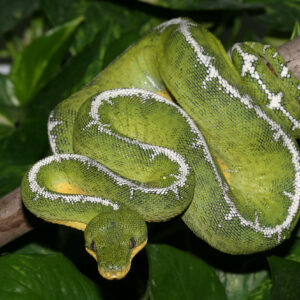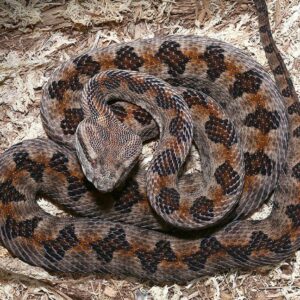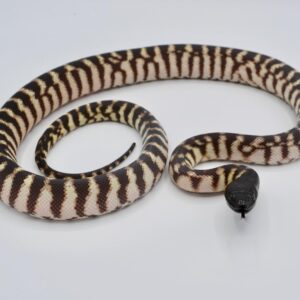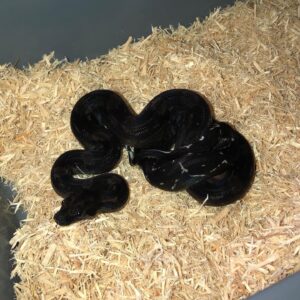Green Anaconda For Sale
$1,200.00
(Eunectes murinus) Also called the giant emerald emerald snake, common anaconda, also known as common sucuri or water boa, is a boa species within South America. This is one of the most massive and the most long known snake species. There are no Subspecies are known at present. Like all boas is not a venomous constrictor.
“Anaconda” is a term used to describe the snake ” anaconda” typically refers to this particular species, however the term can also be applied to other species belonging to the family Eunectes. The fossils of the snake go in early Late Pleistocene in the Gruta do Urso area.
Behavior
The Hato El Cedral
The mostly night-time anacondas spend their entire lives in or near water. They are able to achieve high speeds while swimming. They usually float below on the waters surface and keep their snouts atop the water. When prey comes by or stops for a take a drink, anaconda bites (without chewing or swallowing the food) and wraps itself around it, wrapping its body. The snake will then contract until it’s suffocated its prey.
Feeding
Senckenberg Museum Exhibit of a Capybara ( Hydrochoerus hydrochaeris ) being taken in by a green anaconda
Primarily aquatic green anaconda are predators that are apex, and eat many different prey species and almost everything they can conquer, which includes amphibians, fish as well as a variety of mammals, as well as other reptiles.
Furthermore,
Particularly large green anaconda are known to consume large prey like deer, tapirs and jaguars and caimans, however these large-sized meals aren’t frequently consumed.
Juvenile green anaconda eat prey, such as small birds, and young caimans that range from 40 to 70 grams in weight. As they grow their diets become more complicated.
More so,
The availability of prey is greater in the grasslands than in the rivers basins. Green anacondas found in both habitats have been observed to take on large prey species typically in the range of 14% to 50% of their own mass.
Some instances of the prey they eat are broad-snouted caimans spectacled caimans, smooth-fronted caimans jacanas, capybaras and red-rumped agoutis and collared peccaries.
Hence,
South American tapirs, boa constrictors brown-banded water snakes green Iguanas, cryptic golden Tegus scorpion mud turtles gibba turtles and Arrau turtles, savanna-side-necked turtles red side-necked turtles Northern pudus.
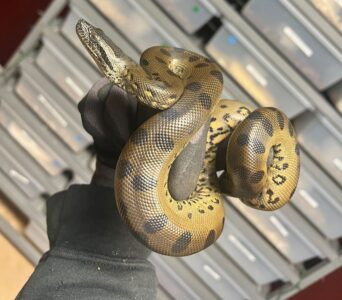
Description
The green anaconda, scientifically known as Eunectes murinus, holds the title of the heaviest snake in the world. This formidable reptile belongs to the Boidae family, which also includes boa constrictors. Native to the tropical rainforests, swamps, and marshes of South America, the green anaconda thrives in aquatic environments, particularly in the Amazon and Orinoco River basins. Its preference for water is a critical aspect of its lifestyle, aiding in both predation and evasion from potential threats.
Physically, the green anaconda is an awe-inspiring creature. It can grow up to 30 feet in length, though the average size is typically between 15 and 20 feet. Adult females are notably larger than males, both in length and girth. This sexual dimorphism is common among many snake species. The green anaconda’s body is robust and muscular, covered in olive-green scales adorned with black blotches running the length of its back. This coloration provides effective camouflage in its murky, aquatic habitats.
One of the most remarkable features of the green anaconda is its sheer mass. Weighing up to 550 pounds, it is the heaviest snake species globally. This immense weight is supported by a powerful musculature that enables the anaconda to constrict its prey with extraordinary force. The snake’s head is relatively small compared to its body, equipped with sharp teeth designed to grip and hold onto struggling prey. Its eyes and nostrils are positioned on top of its head, allowing the anaconda to breathe and see while remaining largely submerged underwater.
Understanding the green anaconda’s classification, habitat, and physical characteristics provides a foundational knowledge that is essential for delving deeper into its complex life and behaviors. This introduction sets the stage for a comprehensive exploration of one of nature’s most fascinating and formidable predators.
Physical Characteristics
The green anaconda, scientifically known as Eunectes murinus, holds the title of the world’s heaviest snake. These colossal reptiles can reach lengths of up to 30 feet, with some rare individuals even exceeding this. However, it is their girth and weight that truly set them apart. While the reticulated python may occasionally surpass the green anaconda in length, the anaconda’s substantial bulk, often weighing over 200 pounds, makes it the heaviest snake on the planet.
The coloration of the green anaconda is another distinctive feature. Its olive-green background is adorned with black circular spots along its body, providing effective camouflage in its native aquatic environments. The skin pattern is both beautiful and functional, allowing the anaconda to blend seamlessly into the murky waters and dense vegetation of the Amazon Basin. This natural camouflage is crucial for both hunting and avoiding potential threats.
Sexual dimorphism is prominently observed in green anacondas, with females being significantly larger than males. Female green anacondas can be nearly five times the mass of their male counterparts. This size disparity is linked to their reproductive role, as larger females can carry more offspring. Males, being smaller and more agile, are better suited to navigate the dense forest and waters in search of mates.
When compared to other large snake species, such as the reticulated python, the green anaconda’s unique combination of immense weight, distinctive coloration, and pronounced sexual dimorphism underscores its unparalleled status in the reptile world. These physical characteristics not only contribute to the green anaconda’s imposing presence but also play a vital role in its survival and reproductive success in one of the most challenging habitats on Earth.
Habitat and Distribution
The green anaconda, scientifically known as Eunectes murinus, thrives in the dense tropical rainforests, swamps, marshes, and slow-moving streams of the Amazon and Orinoco basins. These environments offer the perfect combination of humidity, temperature, and water bodies, essential for the green anaconda’s semi-aquatic lifestyle. The lush vegetation and abundant prey in these regions provide an ideal habitat that supports their growth and survival.
Primarily found in countries such as Brazil, Venezuela, Colombia, Ecuador, Peru, Guyana, and Bolivia, the green anaconda’s distribution is largely confined to South America. These snakes favor water-rich habitats, often residing in murky waters where their camouflaged scales help them remain undetected by both prey and potential threats. The thick canopy of the rainforests also plays a crucial role in maintaining the necessary microclimate, shielding the anacondas from extreme weather conditions.
Unfortunately, the habitat of the green anaconda is under threat due to deforestation and human encroachment. Large-scale logging, agricultural expansion, and urban development have led to significant habitat loss, disrupting the ecological balance and reducing the available space for these majestic reptiles. Moreover, pollution and climate change further impact the delicate ecosystems of the Amazon and Orinoco basins, posing additional challenges to the green anaconda’s survival.
Conservation efforts are imperative to protect these vital habitats and ensure the green anaconda’s continued existence. By promoting sustainable land use practices, enforcing stricter environmental regulations, and supporting reforestation initiatives, we can help mitigate the adverse effects of human activities on these critical ecosystems. Preserving the natural habitats of the green anaconda not only safeguards this incredible species but also maintains the overall health and biodiversity of the region.
Diet and Hunting Behavior
The green anaconda, known scientifically as Eunectes murinus, boasts a varied and formidable diet that underscores its status as one of the most powerful predators in the animal kingdom. This apex predator primarily consumes a wide range of prey, which includes fish, birds, mammals, and even caimans. The diversity in their diet is a testament to their adaptability and dominance in their native South American habitats, particularly the Amazon and Orinoco basins.
Green anacondas employ a highly effective hunting technique that capitalizes on their stealth and strength. Typically nocturnal hunters, these snakes rely on their excellent swimming abilities to ambush prey. By lurking in the murky waters of swamps, marshes, and slow-moving streams, they can remain nearly invisible to their unsuspecting targets. When a suitable prey comes within striking range, the anaconda uses its powerful jaws to seize it, followed by immediate constriction.
The constriction method is a hallmark of the green anaconda’s hunting prowess. Once the prey is caught, the anaconda rapidly coils its muscular body around it, tightening with each exhale of the victim. This method is highly efficient, leading to the rapid subduing of prey through asphyxiation. This powerful constriction allows the green anaconda to take down surprisingly large animals, including capybaras and deer, which can weigh as much as the snake itself.
An interesting aspect of the green anaconda’s feeding behavior is its metabolism. After consuming a substantial meal, an anaconda can go weeks or even months without eating again. This capability is due to their slow metabolic rate, which allows them to efficiently process and store the nutrients from their prey. During this fasting period, the snake remains relatively inactive, conserving energy until it needs to hunt again. This adaptation is crucial for survival in environments where food availability can be sporadic.
Understanding the diet and hunting behavior of the green anaconda offers insight into their role in the ecosystem as both predator and regulator of prey populations. Their impressive hunting skills and metabolic adaptations highlight their evolutionary success in the diverse and often challenging habitats they inhabit.
Reproduction and Lifespan
The green anaconda, known for its formidable size and weight, exhibits fascinating reproductive behaviors. Mating season for these giant serpents typically occurs during the wet season, from April to May. During this period, males actively seek out females by following the scent trails they leave behind. A unique aspect of green anaconda reproduction is the formation of “breeding balls,” where multiple males coil around a single female, competing for the chance to mate. This competitive mating ritual can last for several weeks, with the strongest male eventually securing the opportunity to pass on his genes.
Unlike many other snake species, green anacondas give birth to live young rather than laying eggs. After successful mating, the female undergoes a gestation period of approximately six to seven months. During this time, embryos develop within the mother’s body, nourished through a yolk sac until they are ready for birth. When the time comes, the female anaconda gives birth to a litter of live young, typically ranging from 20 to 40 offspring, although litters of up to 100 have been recorded. Each newborn measures about 2 feet in length and is immediately independent, capable of swimming and hunting from birth.
The lifespan of green anacondas varies depending on their environment. In the wild, these snakes can live for about 10 to 12 years, although instances of individuals living up to 15 years have been documented. Their survival is influenced by factors such as predation, availability of prey, and environmental conditions. In captivity, where they are protected from natural threats and provided with a steady diet, green anacondas can live significantly longer, often reaching up to 30 years. Such longevity in captivity highlights the importance of controlled environments in studying and preserving these remarkable reptiles.
Behavior and Adaptations
The green anaconda, often celebrated as the world’s heaviest snake, exhibits a variety of behavioral traits and adaptations that have enabled it to thrive in the diverse environments of South America. One of the most notable aspects of the green anaconda’s behavior is its primarily solitary nature. These formidable reptiles are known to spend much of their lives alone, coming together only during the mating season. This solitary lifestyle reduces competition for food and other resources, enhancing their ability to survive in the wild.
Green anacondas are both terrestrial and aquatic animals, showcasing remarkable versatility in their habitat utilization. While they are capable of moving on land, they are particularly adept swimmers, often found in swamps, marshes, and slow-moving rivers. Their bodies are streamlined for swimming, and they can stay submerged for extended periods, using their nostrils positioned on top of their snouts to breathe while keeping the rest of their body hidden underwater. This adaptation allows them to ambush prey with incredible stealth.
The green anaconda’s swimming skills are matched by their sensory adaptations, which play a crucial role in their survival. They possess specialized heat-sensing pits along their upper lip, which enable them to detect the body heat of warm-blooded prey, even in complete darkness. This adaptation is particularly useful for hunting at night or in murky waters where visibility is low. Additionally, their forked tongue flicks in and out, collecting scent particles from the air and water, which are then analyzed by the Jacobson’s organ in the roof of their mouth. This keen sense of smell helps them track and locate prey over considerable distances.
In conclusion, the green anaconda’s solitary behavior, dual habitat utilization, and specialized sensory adaptations collectively contribute to its status as a dominant predator in its natural environment. These evolutionary traits not only facilitate their survival but also underscore the intricate balance of nature that sustains these magnificent creatures.
Interactions with Humans
The green anaconda, often shrouded in mystery and sensationalism, has a complex relationship with humans. Historically, these formidable reptiles have been the subject of numerous myths and misconceptions. Stories of monstrous anacondas capable of devouring boats or entire villages are common in local folklore, but these are exaggerated narratives that do not reflect the true nature of these snakes. In reality, green anacondas are elusive creatures that prefer to avoid human contact.
Their portrayal in media and popular culture has further amplified these misconceptions. Movies and television shows frequently depict green anacondas as aggressive predators, lurking in wait to ambush unsuspecting victims. While these portrayals are captivating, they are far from accurate. Green anacondas are ambush predators, primarily preying on aquatic and terrestrial animals. Human encounters are rare, and instances of attacks on humans are even rarer.
Despite their intimidating size, green anacondas do not pose a significant danger to humans. Most interactions occur when humans encroach on their natural habitats, leading to potential conflicts. These snakes are more likely to retreat than to engage when confronted by humans. However, it is essential to exercise caution and respect their space to avoid any unintended consequences.
Conservation efforts are crucial in protecting green anaconda populations from threats such as hunting and habitat destruction. These snakes are often hunted for their skin, which is highly valued in the fashion industry. Additionally, deforestation and wetland drainage pose significant threats to their habitats. Conservation initiatives focus on habitat preservation, anti-poaching measures, and public education to dispel myths and promote coexistence.
In conclusion, understanding the true nature of green anacondas and addressing misconceptions can foster a more informed and respectful relationship between humans and these magnificent creatures. Conservation efforts play a vital role in ensuring their survival and maintaining the ecological balance they help sustain.“`html
Conservation Status and Future Outlook
The conservation status of the green anaconda, one of the most enigmatic species in the animal kingdom, is a topic of significant concern. Currently, the green anaconda is not listed as endangered or threatened on a global scale. However, it is essential to recognize that regional population trends can vary, with some areas experiencing more severe declines than others. Environmental changes, such as deforestation and habitat fragmentation, pose substantial threats to their natural habitats, primarily the tropical rainforests and wetlands of South America.
Human activities, including illegal hunting and the pet trade, also significantly impact green anaconda populations. The demand for their skins and other body parts has led to targeted hunting, which disrupts local ecosystems. Furthermore, the encroachment of human settlements into anaconda habitats results in increased human-wildlife conflicts, often leading to the killing of these snakes out of fear or for protection.
In response to these challenges, various conservation initiatives have been implemented to safeguard the future of the green anaconda. Efforts include habitat preservation, stricter enforcement of anti-poaching laws, and community education programs aimed at reducing human-anaconda conflicts. Organizations and researchers are also working on gathering more comprehensive data on the population dynamics and ecology of green anacondas to inform more effective conservation strategies.
Moreover, international collaborations are crucial for the conservation of this species. By fostering partnerships between governments, NGOs, and local communities, we can create a more sustainable approach to preserving the green anaconda’s natural habitats. Public awareness campaigns play a pivotal role in changing perceptions and reducing the demand for anaconda-derived products.
Looking ahead, there is hope for the green anaconda. With continued conservation efforts and increased global awareness, it is possible to mitigate the threats they face and ensure that these majestic creatures continue to thrive in the wild. By prioritizing the protection of their habitats and addressing the root causes of population decline, we can pave the way for a brighter future for the world’s heaviest snake.



